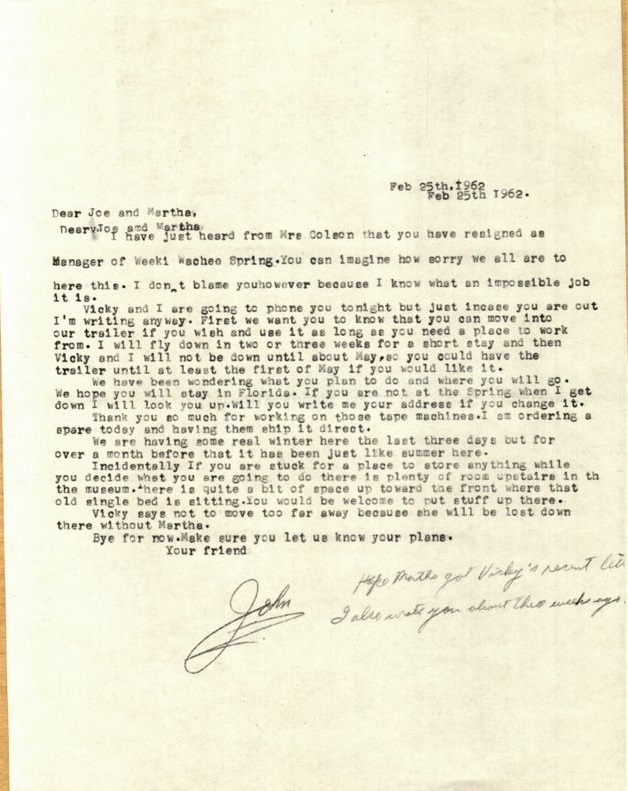Letter from John May to Joe and Martha Seltzer (February 25, 1962)
Dublin Core
Title
Letter from John May to Joe and Martha Seltzer (February 25, 1962)
Alternative Title
Letter from May to the Seltzers(February 25, 1962)
Subject
Weeki Wachee Springs (Fla.)
Tourism--Florida
Springs--Florida
Parks--Florida
Buildings--Florida
Entomology
Description
A letter from John May to Joe and Martha Seltzer, the management of Weeki Wachee Springs. The letter details May's sadness that Seltzer was resigning. May expresses that he hopes to remain in contact and that Seltzer and his wife can leave their things in a back room in the museum temporarily while they look for a new place.
The May Natural History Museum of the Tropics is a non-profit organization that displays the world’s largest private insect collection. James May acquired the thousands of insects and arthropods that make up the collection from the late 1800s until his death in 1956. John May continued his father’s legacy, building a museum in Weeki Wachee, Florida, that lasted from 1954-1964, and a museum in Colorado that opened in the 1950s and is still open today. John May also took parts of the collection across the United States and Canada to display at fairs and exhibitions.
Along with a group of investors, Newton Perry opened Weeki Wachee Springs to the public in October of 1947. At the time, roadside attractions were becoming popular stops along Florida roadways. The attraction consisted of an amalgamation of vendors, an orchid garden, a river boat tour, as well as the star attraction: a mermaid show that took place in an underwater theater. Eventually, the May Museum of the Tropics, an "abandoned Seminole village", a show called “Birds of Prey”, and a petting zoo were added. After peaking in the 1950s and 1960s, attendance began to decline as theme parks and highways changed the dynamics of Florida's tourism. The State of Florida took over the attraction as a state park in 2008. Since then, the park has focused on appealing to a modern audience while preserving its history.
The May Natural History Museum of the Tropics is a non-profit organization that displays the world’s largest private insect collection. James May acquired the thousands of insects and arthropods that make up the collection from the late 1800s until his death in 1956. John May continued his father’s legacy, building a museum in Weeki Wachee, Florida, that lasted from 1954-1964, and a museum in Colorado that opened in the 1950s and is still open today. John May also took parts of the collection across the United States and Canada to display at fairs and exhibitions.
Along with a group of investors, Newton Perry opened Weeki Wachee Springs to the public in October of 1947. At the time, roadside attractions were becoming popular stops along Florida roadways. The attraction consisted of an amalgamation of vendors, an orchid garden, a river boat tour, as well as the star attraction: a mermaid show that took place in an underwater theater. Eventually, the May Museum of the Tropics, an "abandoned Seminole village", a show called “Birds of Prey”, and a petting zoo were added. After peaking in the 1950s and 1960s, attendance began to decline as theme parks and highways changed the dynamics of Florida's tourism. The State of Florida took over the attraction as a state park in 2008. Since then, the park has focused on appealing to a modern audience while preserving its history.
Creator
May, John
Source
Original letter from John May to Joe and Martha Seltzer, February 25, 1962: May Natural History Museum Colorado Springs, Colorado.
Publisher
Date Created
1962-02-25
Is Format Of
Digital reproduction of original letter from John May to Joe and Martha Seltzer, February 25, 1962.
Is Part Of
Weeki Wachee Collection, Hernando County Collection, RICHES.
Format
image/jpg
Extent
104 KB
Medium
1-page typed letter
Language
eng
Type
Still Image
Coverage
May Museum, Weeki Wachee Springs State Park, Weeki Wachee, Florida
Accrual Method
Donation
Mediator
History Teacher
Humanities Teacher
Provenance
Originally created by John May and published by RICHES.
Rights Holder
Copyright to this resource is held by May Natural History Museum and is provided here by RICHES for educational purposes only.
Contributing Project
Rebecca Schwandt's Thesis Project
Curator
Sawhney, Sabrina
Digital Collection
Source Repository
External Reference
Allman, T.D. Finding Florida: The True History of the Sunshine State. New York: Atlantic Monthly Press, 2013.
Ammidown, Margot. "Edens, Underworlds, and Shrines: Florida’s Small Tourist Attractions." The Journal of Decorative and Propaganda Arts 23, 1998, 238-259. Accessed November 9, 2018. https://www.jstor.org/stable/1504171?seq=1#metadata_info_tab_contents.
Georgiadis, Bonnie and Lu Vickers. Weeki Wachee mermaids: thirty years of underwater photography. Gainesville: University Press of Florida, 2012.
Hollis, Tim. Glass Bottom Boats &
Mermaid Tails: Florida's Tourist Springs. Mechanicsburg, PA: Stackpole Books, 2006.
Pelland, Maryan. Weeki Wachee Springs. Arcadia Publishing Inc, 2006. .
Revels, Tracy J. Sunshine Paradise: A History of Florida Tourism. Gainesville: University Press of Florida, 2011.
Vickers, Lu, and Sara Dionne. Weeki Wachee, City of Mermaids: A History of One of Florida's Oldest Roadside Attractions. Gainesville: University Press of Florida, 2007.
Collection
Citation
May, John , “Letter from John May to Joe and Martha Seltzer (February 25, 1962),” RICHES, accessed December 29, 2025, https://richesmi.cah.ucf.edu/omeka/items/show/11063.
